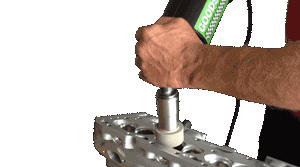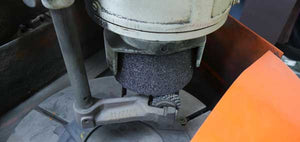Goodson Gazette
Cylinder Boring Tips
Lightweight block castings have become very prevalent in our market. Since the overall mass has been reduced, the controlled stresses have become an important factor in the block’s integrity. To ensure integrity, we must recreate that stress by using a Torque Plate when boring and honing.
Always begin by torquing your main caps in place to correct specifications. Next, install a torque plate and torque in place using final assembly torque specifications. Also, we recommend using correct length bolts. If they are too long or too short, they may abnormally stress the block. The future will even dictate correctly torquing all external motor mounts and related accessory brackets.
Allow .003″ minimum material in the cylinder bore. Remove broken and partially severed material by honing after the boring operation.
Choosing the power source for your portable hone
Portable hones may be driven by a heavy-duty electric drill, air drill or drill press. Optimum RPM is calculated by dividing 1200 by the bore diameter in inches (for example: 1200 / 6 inches = 200 RPM) or by dividing 30,000 by the bore diameter in millimeters (for example 30,000 / 150mm = 200 RPM). If the power source is a drill press or other rigid stroking device, make sure your portable hone is equipped with two universal joints to provide full floating action at the honing head.
Remember, if you have more questions, contact the Goodson Tech Department at 1-800-533-8010 (customers outside the US & Canada, please call 507-452-1830).
Take a seat – a valve seat that is
By way of introduction, let me say that this is going to be an “entry level” summary valve seat work.
I’ll assume that if you’re reading this, you know what a valve seat is and have at least a passing knowledge of why you grind or cut seats but just so we’re all on the same page, here’s the definition I’m working from:
The object of grinding or cutting is to obtain a valve seat of a specified, uniform width in the correct position on the valve face with minimal stock removal.
Get Your Head Together – And Apart!
There are a lot of ways to disassemble a cylinder head. You’ve probably used the old hammer and socket method many times for the standard Chevy and Fords. Don’t do it! Assembly of the cylinder head is compromised and will create a whole new set of problems.Holes in Your Head … Or The Fine Art of Crack Detection
Let’s talk about why we check for cracks in heads and blocks. The obvious reason is that you can’t fix what you don’t know is there. Cracks and pinholes in heads and blocks can lead to a loss of power in the engine, resulting in poor performance. That, unfortunately, is the best-case scenario. Cracks or pinholes can also lead to overheating and complete engine failure, not to mention dissatisfied customers returning again and again in search of that elusive leak.Use your 3-D Fast Cut™ System to Remove Valve Seat Inserts Without Damaging the Counterbore
If you’ve been working on cylinder heads for any time at all, you’ve had to remove a valve seat insert or two, so you know it’s not an easy job. Those suckers are in there tight – and they’re supposed to be – but that makes it tough to get them out. Find out how to use the 3-D Fast Cut System to remove seat inserts.4 Ways to Produce an Ideal Cylinder Head Surface Finish
Produce an ideal cylinder head finish with these four tips: 1. Dress and True the Wheel, 2. Use the Proper Wheel Speed, 3. Use Grinding Fluid, 4. Select Top Quality Abrasives.
Increase the life of your crankshaft polisher with routine maintenance
Help stop premature motor failure by simply spending a few seconds every day to perform routine maintenance on your polisher.
- Use regulated compressed air or a vacuum to remove abrasive and metal particles that have accumulated in the electric motor during normal operation.
- Remove frayed belt threads that collect on roller bearings.
6 Ways to Improve Flywheel Grinding Stone Performance
Use these tips to get better results, longer stone life and lower-cost flywheel grinding.
1) Match the stone to the material.
Most American automotive flywheels are cast iron. Most truck, bus and agricultural flywheels are cast steel. High-performance and a few import flywheels are billet steel.


